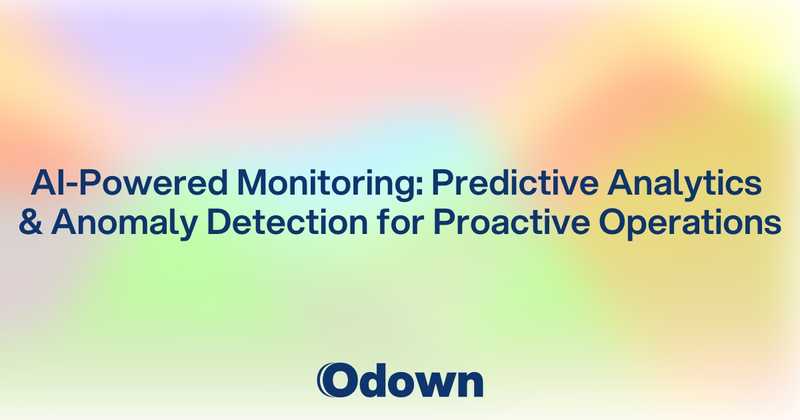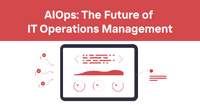AI-Powered Monitoring: Predictive Analytics and Anomaly Detection for Proactive Operations
Your server crashes at 3 AM, taking down your entire e-commerce platform during peak international shopping hours. The failure seems sudden, but looking back, the warning signs were there for weeks---subtle changes in memory usage patterns, gradual increases in response times, and unusual error distributions. A human could never have connected these dots, but AI could have predicted this failure days in advance.
Traditional monitoring tells you what happened after problems occur. AI-powered monitoring predicts what will happen before failures impact your users. This shift from reactive to proactive operations represents the biggest advancement in monitoring technology since the introduction of automated alerting.
Machine learning transforms monitoring from a damage control exercise into a predictive maintenance system. Instead of waiting for thresholds to be crossed, AI systems learn normal behavior patterns and detect subtle deviations that indicate developing problems.
Advanced monitoring platforms integrate AI capabilities to provide predictive insights alongside traditional metrics. But implementing AI-powered monitoring effectively requires understanding machine learning principles, data requirements, and the practical challenges of operationalizing predictive systems.
Machine Learning in Monitoring: Anomaly Detection and Pattern Recognition
Machine learning brings sophisticated pattern recognition capabilities to monitoring, enabling detection of complex anomalies that rule-based systems would miss entirely.
Supervised Learning for Known Problem Patterns
Supervised learning excels at recognizing problems that have occurred before and learning from historical incident data:
Historical incident analysis trains models to recognize the precursors to known failure modes. If database connection pools typically show specific patterns before exhaustion, ML models can learn to detect these patterns early.
Failure mode classification helps categorize different types of problems based on their symptoms. Machine learning can distinguish between hardware failures, software bugs, and capacity issues based on metric patterns.
Time-to-failure prediction models estimate how long systems can continue operating under current conditions. These models help teams plan maintenance windows and allocate resources appropriately.
Unsupervised Learning for Unknown Anomalies
Unsupervised learning detects novel problems that haven't been seen before by learning what normal operations look like:
Baseline behavior modeling establishes what normal system behavior looks like across multiple dimensions. These models adapt over time as systems evolve and usage patterns change.
Multivariate anomaly detection considers relationships between different metrics rather than analyzing each metric in isolation. A combination of slightly elevated memory usage and increased network traffic might be normal individually but anomalous together.
Clustering analysis groups similar operational states and identifies outliers that don't fit established patterns. This approach helps detect novel failure modes that haven't been encountered previously.
Ensemble Methods for Robust Detection
Combining multiple machine learning approaches provides more reliable anomaly detection than any single method:
Model consensus mechanisms require multiple models to agree before triggering alerts. This approach reduces false positives while maintaining sensitivity to genuine problems.
Confidence scoring provides guidance about how certain the AI system is about its predictions. High-confidence predictions might trigger immediate alerts, while low-confidence predictions might require human review.
Model diversity ensures that different types of anomalies get detected by using models with different strengths and weaknesses. Combining time-series models, clustering algorithms, and neural networks provides comprehensive coverage.
Predictive Maintenance: Forecasting System Failures Before They Happen
Predictive maintenance applies machine learning to forecast when systems are likely to fail, enabling proactive repairs that prevent outages rather than responding to them.
Infrastructure Health Prediction
Predictive models can forecast hardware and infrastructure failures before they impact service availability:
Disk failure prediction analyzes SMART data, I/O patterns, and error rates to predict when storage devices are likely to fail. Early warning enables data migration and hardware replacement during planned maintenance windows.
Memory degradation detection identifies patterns that indicate impending memory failures. Gradual increases in correctable errors or specific pattern recognition can predict when memory modules need replacement.
Network equipment health monitoring tracks performance degradation that indicates approaching hardware failures. Predictive models can identify when switches, routers, or other network components need attention.
Application Performance Forecasting
Machine learning can predict when application performance will degrade based on usage patterns and resource consumption trends:
Capacity exhaustion prediction forecasts when systems will run out of critical resources like CPU, memory, or storage. These predictions help with capacity planning and proactive scaling decisions.
Performance degradation modeling identifies when application response times or throughput will fall below acceptable levels. Early warning enables optimization efforts before user experience degrades.
Dependency failure prediction analyzes relationships between services to predict when problems in one area will affect dependent systems. This analysis helps prioritize maintenance efforts based on potential impact.
Resource Optimization Recommendations
Predictive analytics can recommend specific actions to prevent predicted problems:
Scaling recommendations suggest when and how to add resources based on predicted demand patterns. Machine learning can optimize scaling decisions to balance cost and performance.
Configuration optimization identifies parameter changes that can prevent predicted performance problems. AI systems can recommend database tuning, cache configuration adjustments, or other optimizations.
Maintenance scheduling optimization balances the risk of system failures against the cost and impact of planned maintenance. Predictive models help determine optimal timing for preventive actions.
AI-Driven Alert Optimization: Reducing False Positives with Smart Filtering
False positive alerts are one of the biggest problems in traditional monitoring. AI-powered systems dramatically reduce alert noise while improving the detection of genuine problems.
Context-Aware Alert Filtering
AI systems consider multiple factors when determining whether alerts deserve attention:
Historical context analysis examines similar situations from the past to determine whether current conditions typically require intervention. If similar metric patterns have resolved themselves in the past, the AI might suppress or de-prioritize alerts.
Environmental factor correlation considers external conditions that might explain unusual metrics. High CPU usage during scheduled backup windows shouldn't trigger the same alerts as unexplained CPU spikes.
Business impact prediction estimates the likely consequences of current conditions. AI systems can prioritize alerts based on predicted business impact rather than just technical severity.
Dynamic Threshold Adjustment
Machine learning enables dynamic alert thresholds that adapt to changing conditions:
Seasonal threshold adaptation accounts for predictable variations in system behavior. Holiday shopping traffic, end-of-month processing, or other business cycles require different alert thresholds.
Load-proportional alerting adjusts expectations based on current system utilization. Error rates that are normal under high load might be concerning during low-traffic periods.
Trend-based threshold modification considers whether metrics are improving or degrading over time. A metric that's high but improving might not need immediate attention.
Alert Correlation and Aggregation
AI systems can group related alerts into coherent incident narratives:
Root cause correlation identifies underlying issues that manifest as multiple symptoms. Instead of receiving separate alerts about high response times, database slowness, and increased error rates, teams get one alert about a database performance issue.
Cascade effect prediction anticipates which additional alerts are likely to fire based on current problems. AI systems can suppress predicted cascade alerts to reduce noise.
Resolution prediction estimates how long problems are likely to persist and whether manual intervention is needed. Some issues resolve themselves quickly and don't require human attention.
Natural Language Processing for Log Analysis and Incident Correlation
NLP technology transforms unstructured log data into actionable insights and helps correlate information across different systems and time periods.
Automated Log Pattern Recognition
Natural language processing can identify meaningful patterns in unstructured log data:
Error message classification groups similar error messages together even when they have different specific details. This classification helps identify recurring problems that might not be obvious from individual log entries.
Intent extraction identifies what systems were trying to accomplish when errors occurred. Understanding user intent helps prioritize fixes based on impact to user workflows.
Severity inference determines how serious log messages are based on their content rather than just explicit severity levels. NLP can identify concerning patterns even when logs don't include proper severity indicators.
Cross-System Correlation
NLP enables correlation of information across different log formats and systems:
Entity extraction identifies common elements like user IDs, transaction IDs, or IP addresses across different log sources. This extraction enables correlation of events across multiple systems.
Timeline reconstruction builds chronological narratives of user activities or system events by analyzing logs from different sources. NLP helps piece together complex incidents that span multiple systems.
Causal relationship identification analyzes log content to understand which events caused other events. This analysis helps with root cause identification and prevention strategies.
Incident Documentation and Knowledge Management
NLP can automatically generate incident documentation and maintain organizational knowledge:
Automated incident summaries generate concise descriptions of problems and resolutions based on log analysis and resolution actions. These summaries improve knowledge management and help train team members.
Resolution pattern recognition identifies common solution patterns that can be automated or documented as runbooks. NLP can extract actionable procedures from historical incident data.
Knowledge graph construction builds relationships between different types of problems, systems, and solutions. This graph helps with decision support and training for new team members.
AI-powered monitoring builds on traditional monitoring foundations while adding predictive capabilities. Alert fatigue prevention strategies become even more important when implementing AI systems that can generate sophisticated alerts.
Ready to implement AI-powered monitoring that predicts problems before they impact your users? Use Odown and gain the predictive capabilities you need to transform your operations from reactive firefighting to proactive problem prevention.



